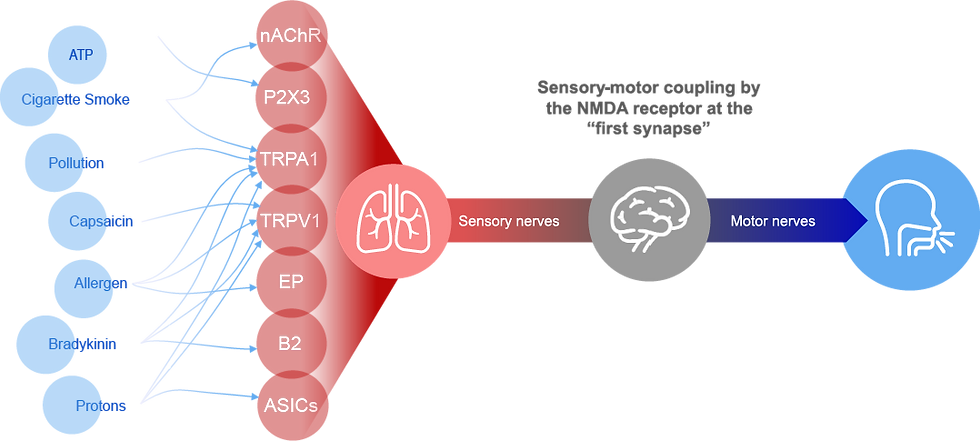SEYLTX

GluN2B Antagonism
“The holy grail in this indication is a centrally acting, non-narcotic, not-sedating drug”
- Peter Dicpinigaits, MD, Professor, Albert Einstein School of Medicine; Editor-in-Chief, Lung
Refractory chronic cough (or RCC) is a disorder that affects about 6 million people in the USA alone, or about 2% of the global adult population.
The disorder is characterized by at least 8 weeks of unremitting coughing which, in some people, can last decades. Some individuals with RCC cough more than 100 times per hour.
RCC primarily affects women, often beginning in mid-life. The disorder causes significant anxiety and depression, urinary incontinence, and often results in patients often avoiding social situations and becoming socially isolated. Patients sometimes report being so hopeless that they can no longer go on.
The disorder has only recently been clinically defined and thus has not yet come into mainstream recognition – patients suffer in silence.
The root of the disorder is hypersensitivity of neurons which causes an increased signaling of the cough reflex pathway. Despite strong interest on the part of large pharmaceutical companies, there remain no approved effective therapies for patients suffering with RCC.
RCC is not the only chronic cough disorder. In fact, there are numerous adult and pediatric forms of chronic cough. One form is chronic cough associated with idiopathic pulmonary fibrosis (IPF-CC). About 85% of IPF patients have a chronic cough that is an independent predictor of mortality. This form of cough affects between 100-140 thousand patients in the US alone. There exists no effective therapy.
Morice et al., Eur Respir Rev, 2021, 30, 21027; EHR Data (Stephan et al, London Cough Symposium 2024); Raghu et al., Eur Resp J, 2016, 48, 179-186; Mann et al., Front Rehab Sci, 2021, 2, 751798
Ifenprodil significantly reduces cough count and time to cough in vivo in preclinical models
-
Inhibits cough by up to ~75% from baseline in gold-standard animal model (p<0.05)
-
Exhibits dose-responsiveness, a key feature of “on-target” therapies
-
Aligns with NHP receptor occupancy studies
-
Achieves significant cough count reductions well below the NOAEL
-
Ifenprodil significantly reduces 24-hour cough counts and VAS scores in Phase 2a clinical trials in difficult-to-treat (IPF) patients with cough
An open-label clinical trial utilizing an exploratory low dose was performed to identify whether Ifenprodil could inhibit cough.
Objective cough count reductions
-
The results show statistically significant reductions in geometric mean cough counts at 4 weeks and 8 weeks from baseline using 24-hour cough monitoring
-
Responder analysis showed clear separation between cough count reductions on ifenprodil vs. placebo data from all prior IPF-refractory chronic cough trials
-
Cough bouts, a measure of what may be most meaningful to patients, appear to be improved over a historical placebo arm
Patient-reported outcomes (PRO) improvements
-
The VAS score, a PRO measure of cough severity, was improved by 37.4% (23.6 mm, p = 0.001)
-
In the Leicester Cough Questionnaire, scores improved over 12 weeks (p = 0.017), and scores were improved in each domain
-
In the Global Rating of Change Scale, 95% of patients reported an improvement or no change in cough frequency after 12 weeks; only 5% felt worse
-
Of the ~60% of patients who reported feeling better of the Global Rating of Change Scale at this exploratory dose, their objective cough count improvements from baseline were ~60% (an accepted meaningful improvement)
This data, at a low exploratory dose, supports a drug effect above placebo. Based on this data, we are moving higher doses into our next clinical trials (2x, 3x, and 4x these doses) to measure tolerability and placebo-controlled efficacy.
-
-
Ifenprodil was well tolerated at this exploratory dose
-
Clinical dosing at 2x the exploratory dose was also well tolerated
-
Our upcoming clinical trials will increase the doses tested to optimize cough count reduction based on preclinical animal studies, which show that increasing the dose improves cough count reductions within the safety margin
-
-
Seyltx plans on conducting dose escalation studies to optimize the therapeutic response
-
Our upcoming clinical trials will increase the doses tested based on preclinical animal studies, which show that increasing the dose improves cough count reductions
-
The trials will utilize a dose escalation crossover design to test tolerability at higher dose as well as efficacy relative to placebo controls
-
Drugging The Central Node In The Cough Circuit
Breathing is essential for life. To protect this vital function, the body has evolved the cough reflex. Toxins or obstructions are sensed in the lungs and trigger a signal that moves up to the brain via sensory neurons. These signals are sensed by the NMDA receptor, which allows the signal to enter the brain and then back down to the muscles to cause a cough. This NMDA receptor is a central node in the cough circuit.

Blocking the NMDA receptor stops transmission of the sensory signals and stops coughing.
Potential for First-in-Class and Best-in-Class Treatment
Numerous studies with a variety of NMDA channel blockers, across a variety of animal species and humans, have shown cough suppression. The challenge with these general NMDA channel blockers is that they cause side effects before achieving significant cough suppression.
Several of our team members, doing work at Johns Hopkins University, identified a sub-type of the NMDA channel named GluN2B, which when blocked with our lead compound significantly stops cough signal transmission in pre-clinical models. Targeting this subunit provides the potential to likely achieve clinically relevant cough suppression without causing side effects.
Based on this work, we are developing small-molecule negative allosteric modulators (inhibitors) of GluN2B. The lead compound is named ifenprodil.
